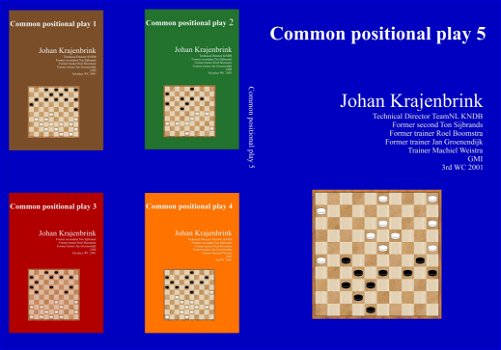
Common positional play 5
Kenmerken
- Conditie
- Nieuw
- Levering
- Ophalen of verzenden
Omschrijving
Common positional play 5 (CPP 5) has been published in English!
New draughts book by Johan Krajenbrink. Based on thirty years of training experience. Size: 170x240 mm and 98 pages.
ISBN/EAN: 978-90-830601-3-2
A short passage from the introduction of Common positional play 5:
Coen Bommel gave me the idea for CPP 5. And Chizhov… And Herman van Silfhout… In my training sessions with Coen Bommel the top player and draughts coach mostly known in Bennekom and Gelderland in the past, Herman van Silfhout, popped up in a conversation and his names for certain positions. This made me remember Chizhov once saying that he knew which positions, which key positions, were favourable to him. Suddenly I thought: I can do something with this. This is a good idea for this CPP series. While preparing for a training session with Coen Bommel I contemplated this some more and I chose one type of key position which in my opinion lends itself well to this series. It’s the type of key position that opens up the possibility of a central surrounding and of classic and of some more things by the way. Does this go well with the rest of the series? Yes, I believe it does: it is yet another way of training positional play.
(…)
Approach
The approach in part 5 differs from the approach in parts 1 to 4. Key positions are the starting point here. Key positions which can have certain systems as a consequence: mainly the surrounding of the centre and the classic. Goal of the earlier parts was clearly to get the reader to be active: a lot of exercises. This is the case here as well. The reader will engage with these key positions in all sorts of ways. We keep circling these with various exercises. Exercises are a good thing: to think and to come up with things yourself! Not merely replaying indiscriminately. The reader will therefore engage with the key positions in a variety of ways, which again is a slightly other way of looking at positional play. You will think about a lot of things:
1. Wat is a key position?
2. Can I come up with a key position myself?
3. Do I know what I can do with the key position?
4. Interesting: how do I attain a key position?
5. What are the possible variations?
6. What if I blindly play towards a key position?
7. Can I subsequently also convert all of my knowledge into beautiful and fitting films?
8. Do I also know to use the films for the division of time and for calculation positions by now?












